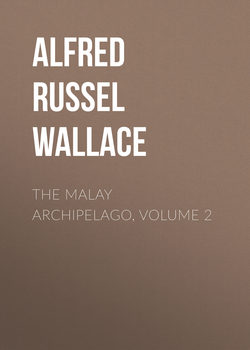The Malay Archipelago, Volume 2

Реклама. ООО «ЛитРес», ИНН: 7719571260.
Оглавление
Alfred Russel Wallace. The Malay Archipelago, Volume 2
CHAPTER XXI. THE MOLUCCAS—TERNATE
CHAPTER XXII. GILOLO
CHAPTER XXIII. TERNATE TO THE KAIOA ISLANDS AND BATCHIAN
CHAPTER XXIV. BATCHIAN
CHAPTER XXV. CERAM, GORAM, AND THE MATABELLO ISLANDS
CHAPTER XXVI. BOURU
CHAPTER XXVII. THE NATURAL HISTORY OF THE MOLUCCAS
CHAPTER XXVIII. MACASSAR TO THE ARU ISLANDS IN A NATIVE PRAU
CHAPTER XXIX. THE KE ISLANDS
CHAPTER XXX. THE ARU ISLANDS—RESIDENCE IN DOBBO
CHAPTER XXXI. THE ARU ISLANDS.—JOURNEY AND RESIDENCE IN THE INTERIOR
CHAPTER XXXII. THE ARU ISLANDS.—SECOND RESIDENCE AT DOBBO
CHAPTER XXXIII. THE ARU ISLANDS—PHYSICAL GEOGRAPHY AND ASPECTS OF
CHAPTER XXXIV. NEW GUINEA.—DOREY
CHAPTER XXXV. VOYAGE FROM CERAM TO WAIGIOU
CHAPTER XXXVI. WAIGIOU
CHAPTER XXXVII. VOYAGE FROM WAIGIOU TO TERNATE
CHAPTER XXXVIII. THE BIRDS OF PARADISE
CHAPTER XXXIX. THE NATURAL HISTORY OF THE PAPUAN ISLANDS
CHAPTER XL. THE RACES OF MAN IN THE MALAY ARCHIPELAGO
Отрывок из книги
I MADE but few and comparatively short visits to this large and little known island, but obtained a considerable knowledge of its natural history by sending first my boy Ali, and then my assistant, Charles Allen, who stayed two or three months each in the northern peninsula, and brought me back large collections of birds and insects. In this chapter I propose to give a sketch of the parts which I myself visited. My first stay was at Dodinga, situated at the head of a deep-bay exactly opposite Ternate, and a short distance up a little stream which penetrates a few miles inland. The village is a small one, and is completely shut in by low hills.
As soon as I arrived, I applied to the head man of the village for a house to live in, but all were occupied, and there was much difficulty in finding one. In the meantime I unloaded my baggage on the beach and made some tea, and afterwards discovered a small but which the owner was willing to vacate if I would pay him five guilders for a month's rent. As this was something less than the fee-simple value of the dwelling, I agreed to give it him for the privilege of immediate occupation, only stipulating that he was to make the roof water-tight. This he agreed to do, and came every day to tally and look at me; and when I each time insisted upon his immediately mending the roof according to contract, all the answer I could get was, "Ea nanti," (Yes, wait a little.) However, when I threatened to deduct a quarter guilder from the rent for every day it was not done, and a guilder extra if any of my things were wetted, he condescended to work for half an hour, which did all that was absolutely necessary.
.....
The most interesting birds I obtained here, were the beautiful blue kingfisher, Todiramphus diops; the fine green and purple doves, Ptilonopus superbus and P. iogaster, and several new birds of small size. My shooters still brought me in specimens of the Semioptera Wallacei, and I was greatly excited by the positive statements of several of the native hunters that another species of this bird existed, much handsomer and more remarkable. They declared that the plumage was glossy black, with metallic green breast as in my species, but that the white shoulder plumes were twice as long, and hung down far below the body of the bird. They declared that when hunting pigs or deer far in the forest they occasionally saw this bird, but that it was rare. I immediately offered twelve guilders (a pound) for a specimen; but all in vain, and I am to this day uncertain whether such a bird exists. Since I left, the German naturalist, Dr. Bernstein, stayed many months in the island with a large staff of hunters collecting for the Leyden Museum; and as he was not more successful than myself, we must consider either that the bird is very rare, or is altogether a myth.
Batchian is remarkable as being the most eastern point on the globe inhabited by any of the Quadrumana. A large black baboon-monkey (Cynopithecus nigrescens) is abundant in some parts of the forest. This animal has bare red callosities, and a rudimentary tail about an inch long—a mere fleshy tubercle, which may be very easily overlooked. It is the same species that is found all over the forests of Celebes, and as none of the other Mammalia of that island extend into Batchian I am inclined to suppose that this species has been accidentally introduced by the roaming Malays, who often carry about with them tame monkeys and other animals. This is rendered more probable by the fact that the animal is not found in Gilolo, which is only separated from Batchian by a very narrow strait. The introduction may have been very recent, as in a fertile and unoccupied island such an animal would multiply rapidly. The only other mammals obtained were an Eastern opossum, which Dr. Gray has described as Cuscus ornatus; the little flying opossum, Belideus ariel; a Civet cat, Viverra zebetha; and nice species of bats, most of the smaller ones being caught in the dusk with my butterfly net as they flew about before the house.
.....